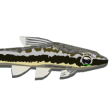The first serious pleco spawning for me began in Apr. 2006 with H. zebra. I used a bare bottom tank. However, I had a tom of rock and wood as well as many caves. Because the fish were very kind to me and spawned a lot, I began to have an ever increasing number of offspring in the tank. I am a believer in leaving the kids to start life in the breeding tank, but there is a limit to this.
The result was at least twice a year i had to pull offspring. The only way to do this it to remove everything in the tank except substrate (if one has it). Small plecos are expert at finding any place they can to hide, even if this is behind a heater. These i often had to detach and move away from the glass. The point of this is that when I did the fry hunts, I also would scrub the bottom glass.
What I can tell you is poop and other wast accumulates in dead spots in BB as well as substrated tanks. My substrate had always been fine gravel, even in most of my planted tanks. I have kept some BB tanks with plants in pots and attached to wood and rocks. However, when I began keeping Altum angels I also began using a sand substrate. Today I have 13 pleco tanks and only that original zebra tank is BB. All the rest have sand.
Now for the kicker- I have gotten something in the range of 500 zebra offspring from that BB tank over the years. I am still getting fry in that tank. But my other species in sanded tanks have also been prolific.
While I would love to use slate bottom tanks, they are heavy and one needs to worry about how the slates is arranged/shaped as debris have a habit of finding any and every hiding place they can. One thing I still do in the BB zebra tank is to use my pumped return water (with a sprinkler type head) to flow water down the bottom edge of the back glass which then runs from the back towards the front of the tank and which works to push hidden debris out towards the front where I can vacuum it out.
I can also tell you that a number of the other 13 pleco tanks started out BB as well. I added sand at a later time. There was no difference I noticed in the behavior or breeding by the inhabitants.
In the wild plecos can live with a lot of current or minimal current. However, they are adapted to be able to suck onto a hard surface as their way not to be tosses about or washed miles down stream. I do not think a pleco can use sand as a surface to which it can adhere. this requires a hard surface. I am not so sure it matters to the fish if that surface is glass, slate, rock, tile etc.
All of the above is moot if one's goal is to create an attractive tank to view as opposed to one dedicated to spawning plecos.What I do believe is that the smaller sized plecos do best in tanks which offer them plenty of cover. The more likely a species is to be food for something else, the more important cover is to them. This is even more true when they live in the confined space of most aquariums.
One observation i can offer. I have kept about 20 tanks from some time. Several of these are planted communities. I have a 150 gal. with 11 assorted clown loaches (biggest 10+ inches) and a bunch of redline barbs. When I approach the tank with food almost all the clowns bunch at the surface near where I usually drop the food. On the other hand, my plecos only come out to eat after the food has hit the bottom and I am not to close to the tank. If I get too close they all bolt for cover. Only the smallest fry have not learned they are supposed to hide, but they stop being "stupid" fairly fast.
The last comment I can offer is that none of my pleco tanks are planted (Darrel is right about the value of a planted substrate). However, I also rely on large amounts of Poret foam for filtration and take steps to insure I have adequate DO in tanks. I have also had BB tanks with plants over years. The one thing I do know is that I have never sucked out sand or fine gravel when siphoning debris out of a BB tank








